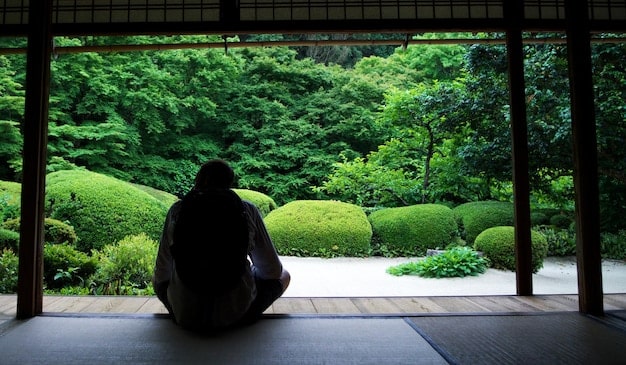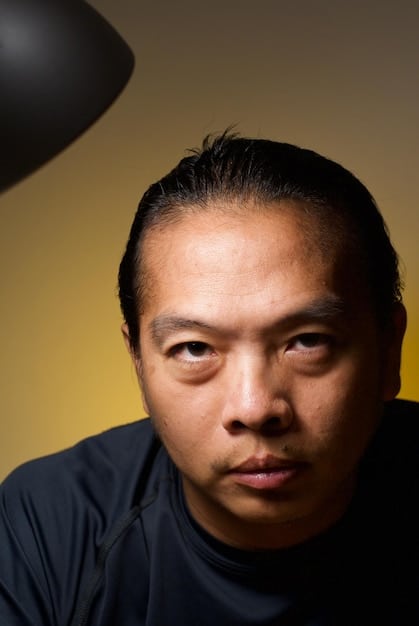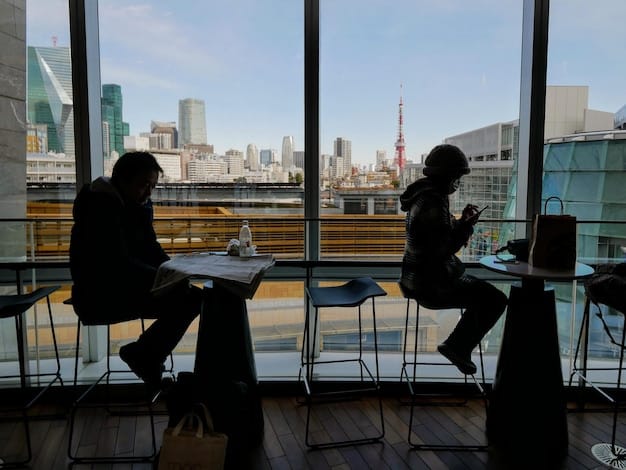Decoding Japanese Silence: Mastering Japanese Communication in 2025

Decoding Japanese Silence in 2025 involves understanding cultural nuances, interpreting non-verbal cues, and responding appropriately to foster effective communication and build stronger relationships, especially within the context of Japanese culture and etiquette.
Navigating the subtleties of Japanese communication can be challenging, especially when silence fills the space. Decoding Japanese Silence: How to Interpret and Respond Appropriately in 2025 is essential for anyone engaging with Japanese culture, whether in business, travel, or personal relationships.
Understanding the Cultural Significance of Silence in Japan
In Japan, silence is not merely the absence of sound; it’s a powerful form of communication that carries significant cultural weight. Understanding this cultural significance is the first step towards effectively decoding Japanese silence.
Silence can convey respect, empathy, thoughtfulness, or even disagreement, depending on the context and the relationship between the individuals involved.
Silence as Respect and Consideration
Silence is often used to show respect, particularly to elders or superiors. By remaining silent, one allows the other person to speak without interruption, signaling deference and attentiveness.
This is also a form of consideration, as it gives the speaker time to fully express their thoughts without feeling rushed or pressured.
- Silence demonstrates active listening and attentiveness.
- It shows respect for the speaker’s position and experience.
- It provides space for thoughtful reflection before responding.
Conversely, interrupting someone while they are speaking is considered rude and disrespectful in Japanese culture.
Silence as a Polite Disagreement
In some situations, silence can signify a polite disagreement. Rather than directly contradicting someone, a Japanese person may choose to remain silent to avoid causing conflict or embarrassment.
This indirect communication style is valued in Japan, where maintaining harmony is often prioritized over expressing individual opinions.
- Silence avoids direct confrontation and preserves social harmony.
- It can signal discomfort or disagreement without causing offense.
- It allows for a face-saving opportunity for both parties.
This is often done to maintain ‘face’ (kao), which refers to one’s reputation and social standing.
Understanding the cultural significance of decoding Japanese silence, particularly its multifaceted and subtle implications, is crucial for anyone seeking to navigate Japanese social and professional landscapes effectively.
The Role of Non-Verbal Cues in Interpreting Silence
While silence itself can be informative, it’s crucial to pay attention to non-verbal cues to fully understand its meaning. Body language, facial expressions, and tone of voice all play a significant role in decoding Japanese silence.
These cues can provide additional context and help you discern the true intent behind the silence.

Reading Body Language and Facial Expressions
Japanese people are often very subtle in their expressions, so it’s important to observe closely. A slight nod, a gentle smile, or a fleeting frown can all provide valuable clues.
Pay attention to their posture, eye contact, and hand gestures, as these can also indicate their level of engagement and interest.
For example, avoiding eye contact might suggest disagreement or discomfort, while a slight bow indicates respect.
Analyzing Tone of Voice and Hesitations
The tone of voice can also reveal a lot about the meaning of silence. A soft, hesitant tone might suggest uncertainty or reluctance, while a firm, confident tone could indicate agreement or approval.
Pay attention to pauses and hesitations, as these can signal thoughtfulness or disagreement, depending on the context.
- Listen for subtle changes in pitch, volume, and pace.
- Observe the length and frequency of pauses.
- Consider the overall emotional tone of the conversation.
Paying attention to non-verbal cues significantly enhances your ability to interpret and empathize, providing a richer understanding of decoding Japanese silence within various interactional contexts.
Common Scenarios Where Silence Occurs
Silence in Japan can occur in a variety of situations, each with its own unique meaning. Recognizing these common scenarios can help you better understand and respond appropriately. Knowing when to expect silence is a central part of decoding Japanese silence.
From business meetings to social gatherings, understanding the context is key to interpreting the silence.
Business Meetings and Negotiations
In business meetings, silence is often used as a strategic tool. It can signify deep consideration, disagreement, or a desire to gain a better understanding of the proposal.
Avoid rushing to fill the silence, as this may be seen as pushy or disrespectful. Instead, use the time to reflect on the points that have been raised and formulate a thoughtful response.
- Allow ample time for discussion and decision-making.
- Avoid interrupting or pressuring others to speak.
- Show patience and understanding, even if the silence feels uncomfortable.
In negotiation scenarios, silence can be extremely powerful if employed correctly, allowing room for subtle concessions and strategic positioning that contribute to a more favorable outcome.
Social Gatherings and Conversations
In social settings, silence can be a sign of respect or thoughtfulness. It can also indicate that someone is not comfortable with the topic of conversation or is unsure how to respond.
Be mindful of the atmosphere and try to gauge the comfort level of the other person. If they seem uncomfortable, change the subject or offer a polite inquiry.
- Be sensitive to the mood and dynamics of the group.
- Avoid controversial or overly personal topics.
- Be prepared to initiate conversation or change the subject.
The ability to interpret these social dynamics is key to decoding Japanese silence and fostering positive interpersonal relationships.
Understanding these common scenarios allows participants to navigate social and professional encounters with greater confidence and cultural sensitivity.
Strategies for Responding Appropriately to Silence
Knowing how to respond appropriately to silence is crucial for effective communication in Japan. The best approach depends on the context and the perceived meaning of the silence. Having strategies prepared is critical for decoding Japanese silence and responding appropriately.
Here are some general guidelines to follow:
Pausing and Reflecting Before Speaking
When faced with silence, resist the urge to immediately fill the void. Instead, take a moment to pause and reflect on what has been said.
This will give you time to formulate a thoughtful response and demonstrate that you are actively listening.
It also shows that you respect the other person’s position and are not simply waiting for your turn to speak.
Asking Open-Ended Questions
If you’re unsure about the meaning of the silence, try asking open-ended questions to encourage the other person to elaborate.
For example, you could say, “I’m interested in hearing more about your perspective on this” or “Could you explain your reasoning in more detail?”
- Frame questions in a non-confrontational manner.
- Avoid leading questions that suggest a desired answer.
- Show genuine interest in understanding their viewpoint.
By taking the time to understand the reasoning behind the silence, you show respect and foster more effective dialogue, enhancing your capacity for decoding Japanese silence in dynamic situations.
Demonstrating Empathy and Understanding
Regardless of the situation, it’s important to demonstrate empathy and understanding. Show that you are aware of the cultural differences at play and that you are making an effort to bridge them.
Acknowledge their perspective and validate their feelings, even if you don’t necessarily agree with them.
This can go a long way in building trust and rapport, even in the face of challenging communication dynamics.
- Use non-verbal cues like nodding and maintaining eye contact.
- Paraphrase their statements to ensure understanding.
- Express appreciation for their willingness to share their thoughts.
By approaching communication with empathy and cultural sensitivity, you can effectively decode Japanese silence and build stronger, more meaningful connections.
Potential Pitfalls to Avoid
Misinterpreting silence can lead to misunderstandings and damaged relationships. Avoiding common pitfalls is a key element of decoding Japanese silence correctly. Knowing what *not* to do is just as important as knowing what to do.
Here are some common mistakes to avoid:
Assuming Silence Means Agreement
One of the biggest mistakes is assuming that silence automatically means agreement. In many cases, silence may indicate disagreement, discomfort, or simply a need for more time to consider the issue.
Always seek confirmation before moving forward, and be prepared to address any underlying concerns or reservations.
Jumping to conclusions can undermine trust and create unnecessary conflict.
Rushing to Fill the Silence
Another common mistake is feeling compelled to immediately fill any silence. This can be seen as pushy, disrespectful, or even insensitive.
Instead, allow the silence to linger and give the other person ample time to formulate their response. This shows that you value their input and are not simply trying to dominate the conversation.
Patience is key to navigating these situations effectively.
Ignoring Non-Verbal Cues
Failing to pay attention to non-verbal cues is another potential pitfall. As mentioned earlier, body language, facial expressions, and tone of voice can provide valuable clues about the meaning of silence.
Be mindful of these cues and use them to inform your interpretation and response.
- Practice active listening and observation skills.
- Seek feedback from trusted colleagues or mentors.
- Engage in cultural sensitivity training.
Consistent attention to non-verbal signals greatly enhances your ability to perform accurate decoding Japanese silence, fostering clearer communication.
The Future of Communication: Adapting to Modern Japan
As Japan continues to evolve, communication styles are also adapting. However, the core values of respect, harmony, and indirectness remain relevant. Effective decoding Japanese silence is still a critical skill for navigating modern Japan.
Here’s what to expect in the future:

The Influence of Technology
Technology is playing an increasingly important role in communication, with email, messaging apps, and video conferencing becoming more prevalent.
However, even in these digital formats, the principles of respect and indirectness still apply. Be mindful of your tone and language, and avoid being overly direct or confrontational.
Electronic communication should be viewed as an extension of traditional face-to-face interactions.
- Use polite and formal language in emails and messages.
- Avoid using slang or jargon that may not be understood.
- Be mindful of time zone differences when scheduling calls or meetings.
Furthermore, understanding how to navigate these digital spaces while respecting cultural nuances contributes to the evolution of decoding Japanese silence in the modern era.
Greater Emphasis on Global Communication
As Japan becomes more integrated with the global community, there is a growing emphasis on cross-cultural communication skills. Many Japanese companies are actively seeking employees who can effectively navigate diverse cultural contexts.
Investing in cultural sensitivity training and language skills can give you a significant advantage in the Japanese business world.
This includes not only learning Japanese language but also gaining a deep understanding of Japanese culture and values.
- Attend workshops and seminars on cross-cultural communication.
- Seek out opportunities to interact with Japanese people in various settings.
- Read books and articles about Japanese culture and etiquette.
Adaptability, respect, and a commitment to understanding are crucial for success in modern Japanese communication. The ability to master decoding Japanese silence in conjunction with these broader skills will position you for success in a globally integrated world.
In conclusion, the future of communication in Japan is built on the foundation of enduring cultural values and contemporary interaction styles. By mastering the nuances of Japanese communication, global citizens and professionals can foster deeper and more meaningful relationships.
Frequently Asked Questions
Is silence always negative in Japanese culture?
▼
How can I show respect when I don’t understand the silence?
▼
What are some non-verbal cues to watch out for?
▼
Facial expressions such as: avoiding eye contact, posture , hesitatin of tone can provide further clues in decoding Japanese silence. Taking notes of these cues will help you to have better understanding.
How is communication evolving for the future?
▼
Is understanding silence important for business relationships?
Understanding silence strengthens business relationships by showing cultural sensitivity and respect. It fosters smoother, more effective interactions.





